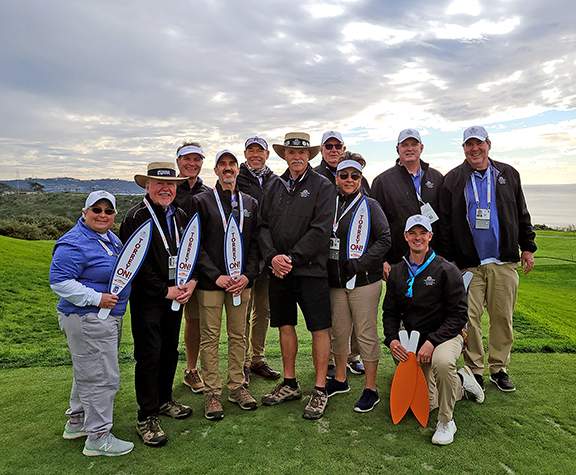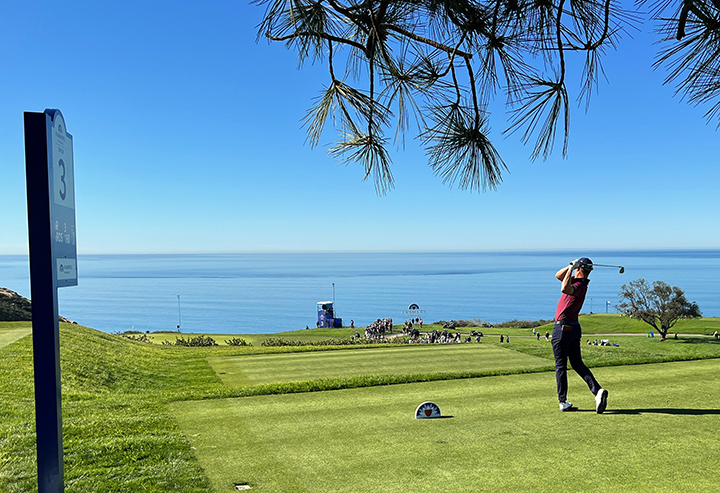
Back to Torrey Pines in late January for for what I think was the 11th consecutive year as a volunteer at the Farmers Insurance Open (still checking on 2015). Third straight year as hole captain of 3 South.
Former Cal golfer Max Homa won the tournament, coming from five strokes behind. Sam Ryder shared the first round lead and was sole leader after rounds two and three. Four holes from the finish, Ryder shot a double-bogey on the 15th. He finished with a 75, tied for fourth, four shots behind Homa.
Homa shot a six-under 66 in the final round to beat Keegan Bradley. Third was Collin Morikawa, another former Cal golfer. Homa took home $1,566,000 and two trophies, one with a representation of a Torrey Pine, the rare and endangered species that grows only in coastal San Diego County, and the other a . . . what else? . . . surfboard.
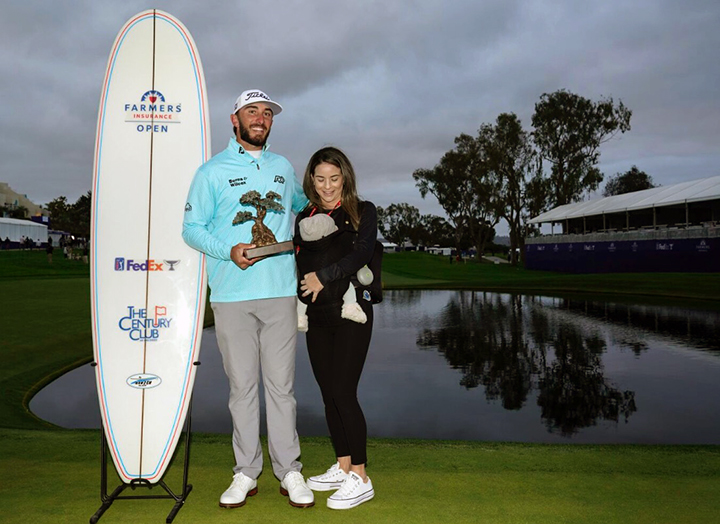
This year’s tournament was the second in a row to end on the last Saturday of January. The schedule had been changed from the usual Sunday finale so as not to conflict with the NFL conference championships, one of which was also broadcast by CBS.
This year, the pro-am returned after a one-year absence (COVID), which brought my crew of “gallery managers” to the course Tuesday-Saturday. It seemed a bit odd at the pro-am, because the public was not allowed on the course and we had no “galleries” to “manage.” Though it started early (first group off the 1st tee at 7 am), there were only 14 groups on each of the two courses (North and South), and we were finished before 11 am. (Until 2022, we were termed “marshals,” which may have been considered too “martial.” Now we are more anodyne managers.)
It was brisk all of the mornings on the course and not “warm” except for Thursday afternoon when it reached the high 60s. It was usually in the high 30s/low 40s when I left home in the morning. Thursday also featured blustery Santa Ana winds throughout the day, sometimes gusting to 30+ mph. Saturday never reached 60 degrees.
I remember past tournaments sometimes featuring a cold day or two, a rainy or even stormy day or two, but this year was steadily less warm than usual. I wore five or six layers on my torso each day, removing my outer official Farmers Insurance Open jacket only during Thursday afternoon. That was the only time my tournament shirt was ever visible.
The big fashion change this year was my hat. The tournament wants hole captains to be distinctive in dress so that officials can locate them at each hole. Whereas gallery managers and other are to wear khaki pants, hole captains wear black pants. Gallery managers wear the issued ball caps and until this year hole captains had worn a wide-brim straw hat with a black hatband. This year, hole captains were issued “hodaddy” hats, apparently to convey better the San Diego surfing culture. Reaction among hole captains was very mixed. Most recognized that the wider brim was better for sun protection, but the style was iffy for many. Here’s a comparison.
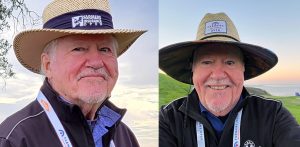 The hodaddy hats were not off-the-shelf products. The tournament logo could have been added to any hat, but these hats featured on the liner under the brim a color drawing of hole #4S, the hole that obviously follows #3S. Distinctive.
The hodaddy hats were not off-the-shelf products. The tournament logo could have been added to any hat, but these hats featured on the liner under the brim a color drawing of hole #4S, the hole that obviously follows #3S. Distinctive.
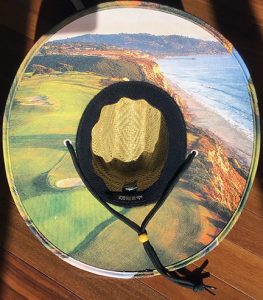 TV announcers for the tournament frequently talk about the beautiful setting at Torrey Pines. There are many wonderful scenes. Here are a couple of aerial views, provided by the CBS drone and Goodyear blimp.
TV announcers for the tournament frequently talk about the beautiful setting at Torrey Pines. There are many wonderful scenes. Here are a couple of aerial views, provided by the CBS drone and Goodyear blimp.
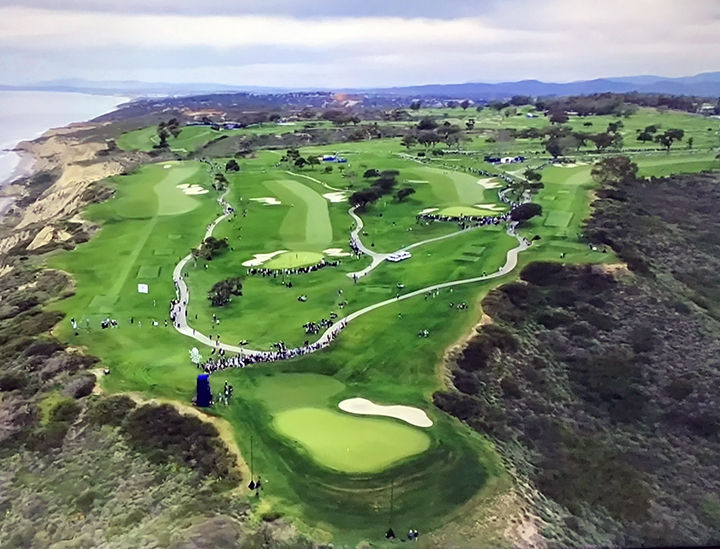
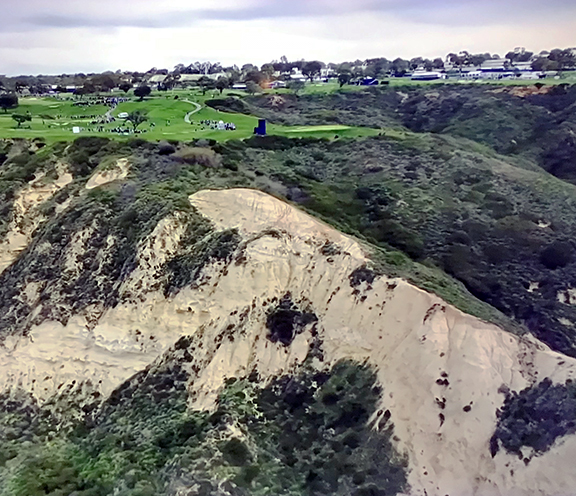
One of the advantages of #3S (for managers) is that fans only have access to the right side of the fairway and green and are quite a distance from the green compared to most other holes.
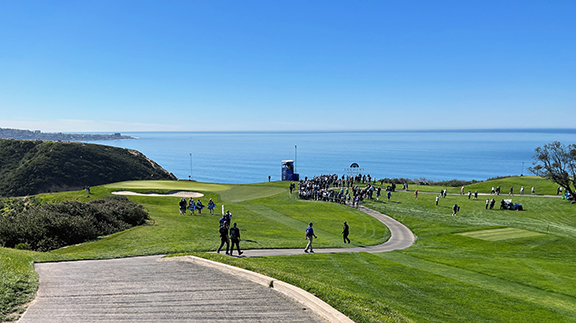
It does sometimes get busy in terms of players, people, etc., especially with several tees and greens close by. The view below shows the close proximity of the 2nd green, 3rd tee (of which there are five, but only two were used in the tournament), 4th tee, and 5th green. Fans following a group on the 3rd tee are often puzzled when they are signaled to be quiet when those players are not teeing off . . . but those on 6 are.
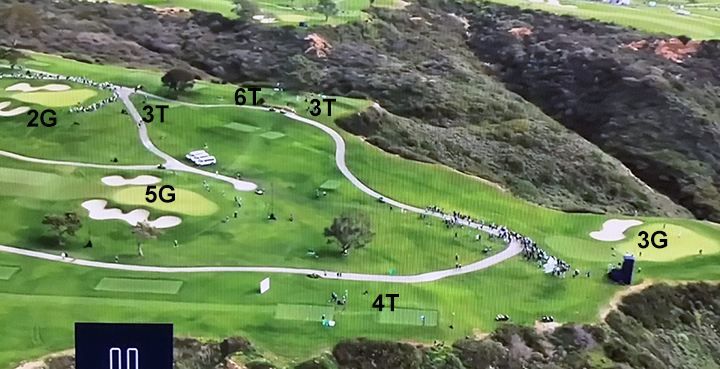 It also can get interesting when the golfers leave the 5th green and cross the 3rd fairway to reach 6th tee. They choose several different routes.
It also can get interesting when the golfers leave the 5th green and cross the 3rd fairway to reach 6th tee. They choose several different routes.
People-watching is another of the pleasures of this volunteer experience. Here were two special sights.
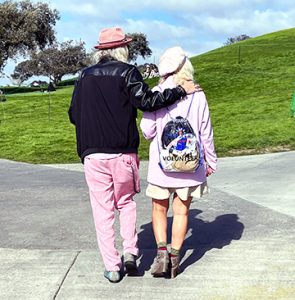
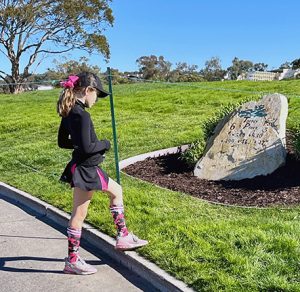
All but two of the members of the 3S crew had worked the hole during my tenure as hole captain. Robin Silva was a welcome addition, as was Andy Nocon, who joined us on Friday and Saturday, moving over from the North Course. Both were as focused, responsible, and fun as veterans Frank Barone, Patti O’Neill, Rick Taylor, Steve Dillard, and Dawn Norman. Steve and Dawn also joined us for the final two rounds from the South.
Two years ago, I believe it was the PGA that chose new titles for the previous marshals and reconfigured the organization of volunteers on each hole. Technology has become increasingly important in providing information to broadcasters. Volunteers with tablets mark on the representation of the hole on their screen the position of each ball after each shot. And that is linked to “the truck,” the central brain of the telecast. That’s how announcers can tell you a golfer has a 238-yard shot or a 16-foot putt.
While the techies had been on the sidelines of each hole in the past, they had been designated two years ago as the “competition support” group and included “tee spotters,” who from the tee indicate with paddles the path of each tee shot, and “ball spotters,” who locate balls hit off the fairway into the rough. These latter tasks had been the responsibility of marshals, under the direction of the hole captain, and tee spotting had been shared among marshals, many of whom enjoyed the task. They are completely separate now, under completely different chains of command.
That differentiation or roles and personnel has still not been smoothly integrated across the board. On as short a hole as #3S, both groups are in close proximity and we’ve been able to work together collegially. Our tee spotter was distinctive. Liam O’Callaghan is 16 years old and a member of his high school golf team. He called in sick to school Wednesday-Friday, but improved greatly on Saturday.
Here’s a photo of the entire team — Gallery Management and Competition Support — at #3S. I don’t know full names of the other CS folk, but will seek to find them out and will update.
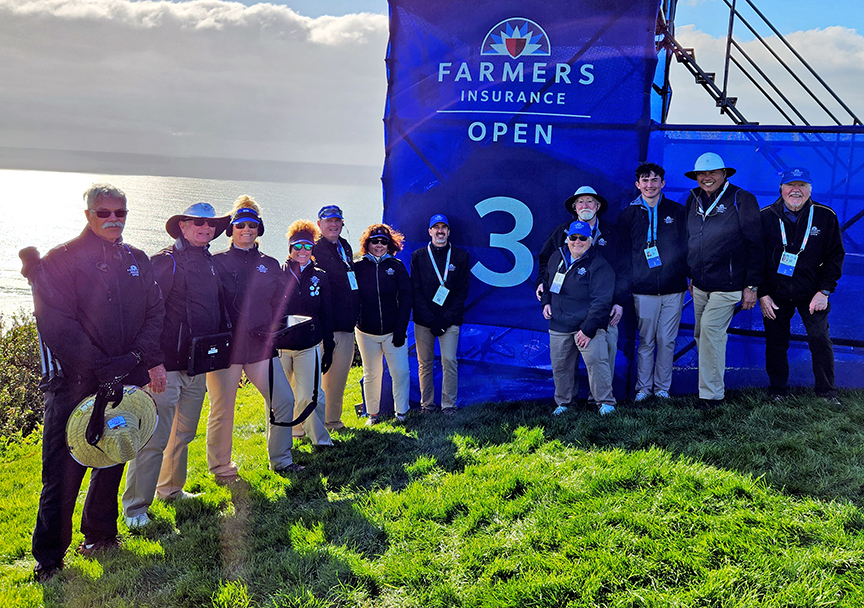 Now, I have to take the new clubs I bought last summer and get out on the links. I’m sure new clubs will transform my game!
Now, I have to take the new clubs I bought last summer and get out on the links. I’m sure new clubs will transform my game!
Ode to 2022
I was seriously remiss in not posting about the 2022 tournament. No real explanation for it. Let me just post a photo of last year’s excellent crew, several of whom returned this year.

